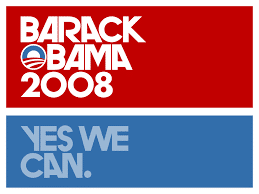

March 30, 2016
Culture of Chaos
From a culture standpoint, there are remarkable similarities between the original Obama campaign and that of Trump.
Most of what we know about culture is actually artifacts of culture. They are the language, signs and symbols that resonate on such a deep emotional level that they shape our present and our future. As author Dave Logan said, “Hitler couldn’t even fire a gun and he took over most of Europe by the sheer power of his words.”
Take a look at the accompanying graphic to see how both Obama and Trump use slogan, symbols and status to rally their base, while the Clinton campaign struggles with the concepts.
Trump – “Make American Great Again.”

Notice how it tells a story by referencing a great past and promising a better future. The words inherently resonate with anyone who loves America but hates the status quo.
Obama – “Yes We Can.”

The phrase is almost hypnotic because it’s a positive word, combined with a community word and a word that means potential. It’s perfectly vague while emotionally bonding. (hat tip to Culture Game author Dan Mezick for noticing the NLP in this)
Clinton – “Hillary for America”

The phrase itself is from every campaign of the past three decades (Person-for-Branch of Government) so it’s automatically connected with the old and the status quo. And it has her name in it making it self-referential with no inherently positive words.
Trump – The hat
Brilliant because it’s an actual tangible item which makes it literally real. It’s like a crown he wears and everyone can buy one and wear one, like wearing the jersey of their favorite athlete.
Obama – The poster

The striking image with the single positive word of Hope, brings back both the revolutionary spirit of a Che Guevara with the pride of the classic Kennedy campaign poster.
Hillary – What?

I can’t find an icon for Hillary except for this attempt at an iconic image to convey the modern woman with a sun behind her back.
America is upset with the government that seems to constantly either get the country in trouble or simply shut it down in a temper tantrum because they can’t get along.
People want an outsider, like Obama was in his first campaign. Trump has never been involved in politics, while Hillary has spent 24 years being guarded by the Secret Service.
If Hillary wins, I believe it will be swayed by those against Trump as opposed to for Hillary.
I think people are slowly beginning to realize that campaigns are not about policy and experience. There is something much more tribal that’s going on here. More on that soon.
March 18, 2015
Culture of Chaos ,Great cultures ,Popular Articles
Everything you know about change management is wrong. (Part 1)
In 1996, John Kotter rocked the business world with his international bestseller, Leading Change. Considered by many to be the seminal work in the field of change management, his 8-step process (outlined below), gave meaning and order to what felt like pure chaos through any big corporate change (a merger, a turnaround, a new system, an enterprise-wide software change – anything that requires a massive change in behavior).
Kotter’s 8 steps to transform your organization are brilliantly conceived. But that doesn’t mean it will work for you. A strategy cannot succeed without the proper culture, thus the famous adage, “Culture eats strategy for breakfast.”
In fact, without the right culture, the 8 steps can cause more damage than if you had never followed it.
Any military commander can tell you there’s a well-crafted battle plan, and then there’s what actually happens on the battlefield. So what happens if soldiers are handed the plan without the skills or resources to deal with the inevitable situation when the train goes off the rails? They’re dead in the water. That’s what happens and that’s why most transformational efforts either fail or simply have lukewarm results.
Here are the three reasons why Kotter’s plan may fail you.
Basic behavioral psychology shows us that unless a change is universally positive, it will produce an emotional response. It will provoke denial, anger, resistance, and avoidance before it finally turns to acceptance.
Asking people to let go of the past way is asking them to move on. And when people are attached, moving on doesn’t happen without grieving.
And where does an 8-point strategic plan include the space to process the emotions of grief? It makes no sense, unless one is so focused on the future that they want to forget the past. That may seem like a good intention, but letting pain remain unprocessed is the equivalent of telling someone in a hospital bed to just get up. Resentment remains, and that can derail cooperation.
Kotter’s plan makes us feel comfortable because we think that we simply have to follow 8 steps in sequential order and then we’ll have our new initiative in place. But change doesn’t happen that way.
Change is messy. Change can look like moving backward or sideways, or in zig zags before moving forward. Change can bring up a lot of painful conversations. The 8 steps are an attempt to process people like they are part of a linear supply chain management procedure.
That’s why operations people love the 8 steps so much. They don’t want to hear about the most effective way to get messy. They want to clean things up as fast as possible and move on.
In reality, you may not get the vision right the first time around. You may need to return to it based on experimental data. The coalition team you assembled may fall apart. Those “short-term wins” may turn into short-term losses and people start to give up and want to “return to Egypt.”
At this point, you as the leader will have lost credibility. Your people will have lost faith in you, and the board will want to replace you with someone who can “drive it through.” But there was nothing wrong with your leadership. You were just trying to follow a strategy, rather than working with the culture first.
One of the most insidious beliefs in corporate management is that we can make people do things. If that were true, there would be no need for an 8-step process in the first place.
People can drag their feet in all kinds of ways, from being unproductive to outright sabotage. And most of it will happen below the radar.
So what happens if we give up entirely on the idea that we can make people do things? What if everything were optional? What if all meetings, initiatives, projects and tasks were voluntary?
Some people believe this would be total chaos. But if you have strong people who care about your company, what might happen if you set them free?
And if you don’t have strong people you believe in, then you have a much bigger problem than any new initiative. Luckily, there are three stages of real change for natural leadership to emerge. That’s for a future post.